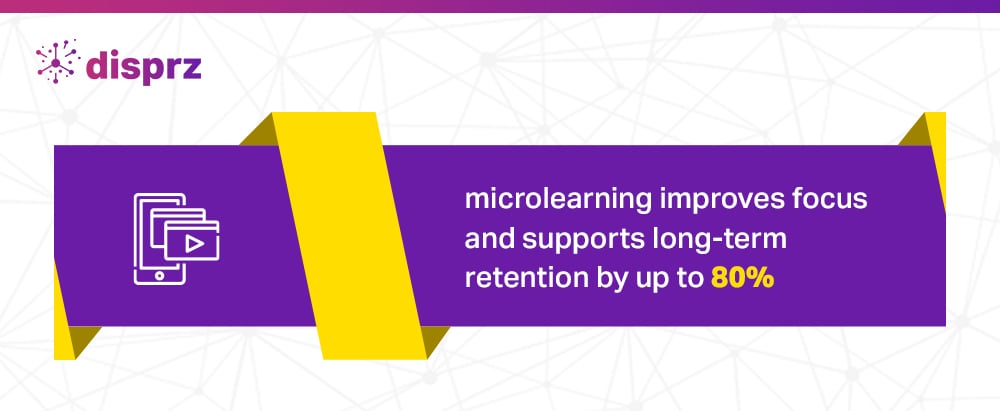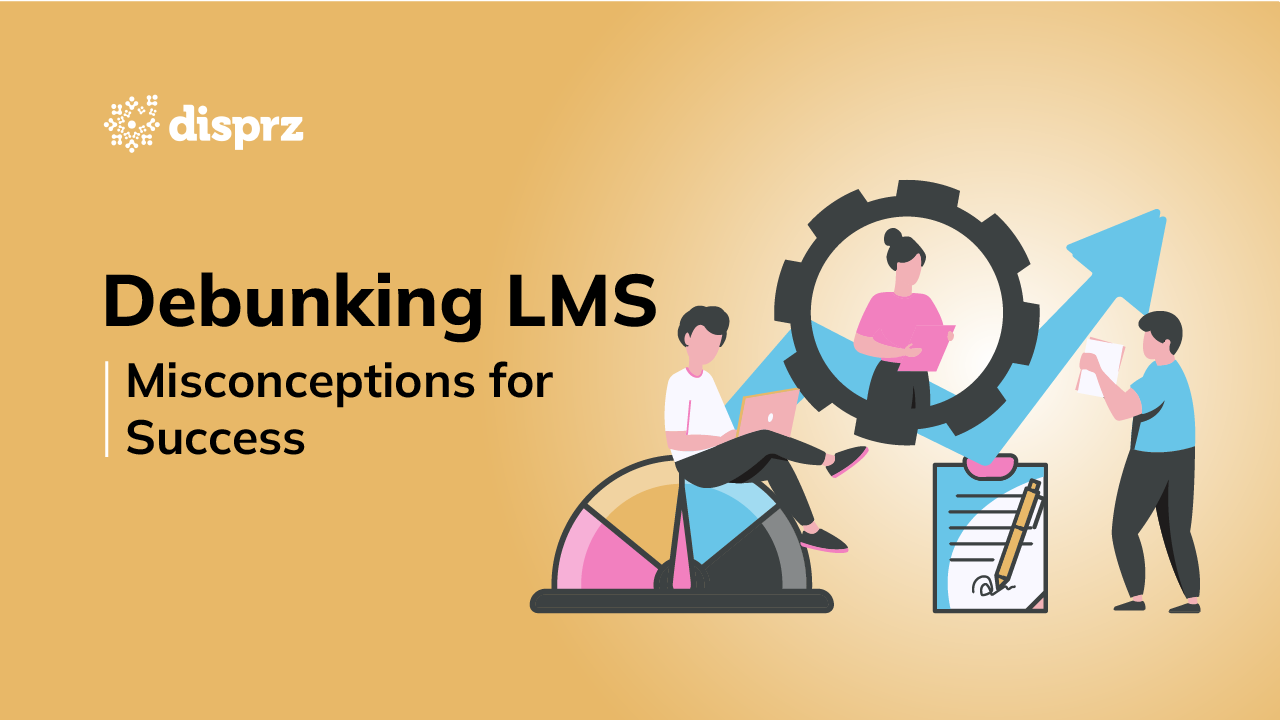With the rise of hybrid work, LMS has steadily grown in popularity, especially post covid. An LMS has the capability to improve workplace productivity and drive business impact.
As per research, 41.7% of companies save huge training costs by implementing LMS
However, due to some misconceptions about LMS, some businesses still doubt this impactful learning solution. We shall throw light on some of the common LMS myths that might hold you back from implementing this powerful learning solution.
10 most Common Misconceptions about LMS that Need Your Attention
Many companies are jumping on the LMS bandwagon and unleashing the power of this advanced learning solution to take employees to the next level.
Have you explored LMS yet?
Or are some inaccurate information clouding your mind with doubts and holding your business back from opting for an LMS solution?
Well, in that case, you are missing out on a lot of benefits that can help in onboarding, upskilling, and making employees future-ready,
Below are the common LMS misconceptions you shouldn’t fall for
LMS Misconception 1
LMS is very expensive and it doesn’t boost business growth
An LMS is a lucrative investment worth making. Most businesses make the mistake of looking at the cost and ignoring the ROI that an LMS offers. Moreover, the modern LMS comes with varied pricing models. So anyone from a startup to a large-scale enterprise can afford it.
All you need to do is make a smart choice based on your business needs. The right LMS helps you align learning with your company goals to boost business growth. So, convene your L&D team, analyze your requirements and choose the apt LMS that works best with your business model.
LMS Misconception 2
LMS are complex to adopt, use and maintain
The LMS market is growing exponentially, and more players are entering the market.
As per research, the learning management system (LMS) market is expected to surpass USD 150 billion by 2028
For thriving and surviving in the competitive LMS space, companies are trying to make the learning solution user-friendly, feature-rich, and intuitive. So, most modern LMS are easy to set up, have a very simple interface, and are packed with excellent functionalities.
Moreover, to gain a competitive edge, LMS vendors offer great support to ensure you make the most of the solution. If you’ve opted for a cloud-based LMS, you don’t need to worry about maintenance. The service provider maintains and updates the learning management solution. The cherry on the cake is that the SaaS-based LMS can be customized to address your company’s unique learning and development requirements. So, next time you hear someone saying that the LMS is complicated and difficult to use, royally ignore it.
LMS Misconception 3
LMS doesn’t have features to boost learner engagement
Engagement is crucial to capture learners’ interests and motivate them to complete the courses. Modern LMS service providers understand this very well, so they are continuously innovating and adding advanced features to boost the learning experience.
For instance, they are adding the gaming element to amp up engagement. The Advanced LMS+ comes with the Gameinar features that help L&D professionals spice up learning sessions with a roulette wheel, live leaderboards, polls, and text wall.
90% of employees say gamification makes them more productive at work
Nowadays, LMS service providers are even offering features like microlearning and mobile learning to ensure learning in the flow of work while boosting engagement. The small bit of information can easily be consumed without investing a lot of time. The bite-sized content doesn’t overburden the working memory, so employees can easily retain knowledge and apply it to work.

Engagement increases when employees are not bound to a particular place or time to learn. With mobile learning, employees get the freedom to learn at their own pace from anywhere. For instance, a sales rep is waiting outside a client’s office. So, he can easily use the mobile LMS to learn something new during that wait time to make his sales presentation better.
Mobile learning improves productivity by 43%
LMS Misconception 4
LMS doesn’t support Social learning and collaboration
This is one of the biggest misconceptions about LMS as the human connection isn’t lost if you start using technology for learning and development. The forward-thinking learning solutions are designed in a smart way to support social learning.
For instance, disprize LMS+ offers a social platform- Buzz, where teammates can collaborate and learn from each other. Anyone can instantly post a query, and the team leader or colleagues can respond to it. Besides, it is one of the best ways to keep employees updated about new policies, procedures, and product updates.
73% of companies expect to increase their focus on social learning
LMS Misconception 5
Due to the language barrier distributed workforce doesn’t use LMS
Industries like manufacturing, logistics, and retail often face the language barrier challenge while learning and developing. However, contrary to the misconception, modern LMS help overcome this barrier to learning.
To increase adoption and engagement, most LMSs support multilingual learning. The likelihood of completing a course is more when the learning program is in a regional language that the employees understand. For instance, one of the leading wine producers created courses in Marathi for their factory workers in Nashik using LMS+ and experienced a higher adoption rate.
LMS Misconception 6
LMS lacks a personalized approach
Among the myths in LMS, it's often believed that these systems don’t offer personalized learning. In fact, an effective LMS tailors learning experiences based on each employee’s needs and preferences. Opt for an LMS that incorporates diverse learning methods like social learning and customized assessments. Modern LMS platforms can also leverage AI and data analytics to track learner progress and suggest personalized learning paths, ensuring individuals focus on areas needing improvement while advancing at their own pace, enhancing both engagement and retention.
LMS Misconception 7
No maintenance is needed post-installation
Another misconception is that an LMS can run without supervision after setup. Skilled administrators are essential to monitor the system, evaluate performance, and ensure the right people are engaged in training. Regular oversight is needed to update content and troubleshoot issues. Administrators also analyze usage data and feedback to refine the training experience, ensuring the LMS stays aligned with evolving organizational goals. Without active management, even the best LMS can lose its impact over time, highlighting the importance of addressing LMS myths surrounding its functionality.
LMS Misconception 8
One LMS will last across generations
A persistent LMS myth is that a single system will suffice indefinitely. However, technology evolves quickly, and an LMS needs periodic updates or replacements to stay relevant. Regular upgrades ensure compatibility with new tools, platforms, and integrations that enhance learning experiences. Evolving employee expectations and industry trends mean your LMS should also support emerging formats like microlearning, virtual reality, or AI-driven personalization. Organizations that fail to reassess their LMS risk missing out on features that could significantly boost engagement and productivity.
LMS Misconception 9
LMS products perform poorly in the industry
A frequent myth in LMS discussions is that these systems are ineffective. In contrast, market reports show that LMS platforms are top performers and widely trusted by large organizations as essential learning tools. These systems streamline training and enhance engagement through interactive, personalized experiences. LMS platforms also allow organizations to track progress in real-time, ensuring learning objectives are met efficiently. With scalable solutions and support for hybrid environments, LMS tools continue to prove their value in fostering a skilled, adaptable workforce.
LMS Misconception 10
LMS isolates learners
It's often assumed that an LMS creates isolated learning experiences. On the contrary, these platforms promote interaction, enabling employees to connect, share insights, and engage in a collaborative learning environment. Modern LMS platforms incorporate features like discussion forums, group projects, and peer feedback to foster teamwork and knowledge-sharing. Additionally, integrating social learning tools allows employees to build a sense of community, enhancing engagement and retention while making learning more dynamic and interactive.
Conclusion
There are misconceptions about almost every technology that is present in the market. However, you cannot blindly believe everything as some technologies can be very beneficial for your business and employees if used in the right way. LMS is one such technology that can make L&D professionals’ work easier and help employee expand their skillset.
With advanced technology like disprz LMS+, you can raise your L&D game. Drive engaging learning experiences at scale with a learning model that suits and adapts across the different colours of collars of your workforce with disprz LMS. It empowers you to track learning analytics with business-linked dashboards. Its multilingual ability helps surge adoption by creating effective learning programs for your employees spread across different cities. With disprz LMS+ introduce the feature-rich system that isn’t just a learning tool but also a communication and engagement platform. See a preview to experience disprz in action.









